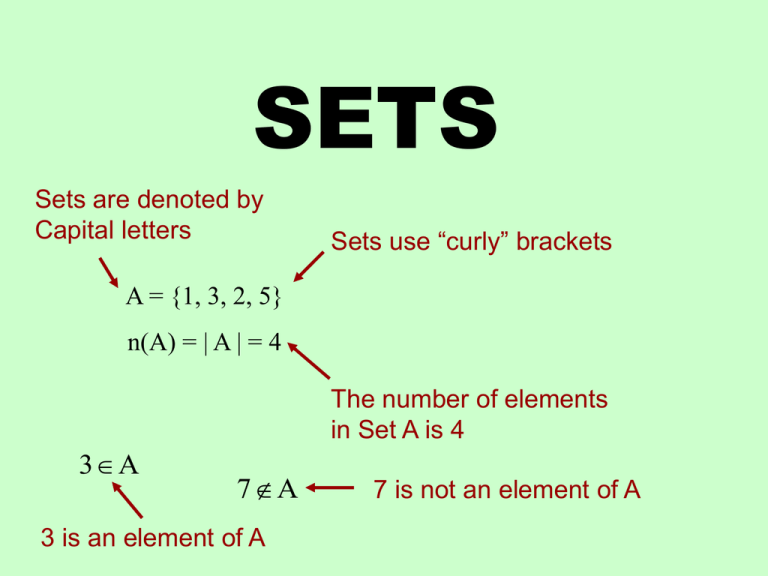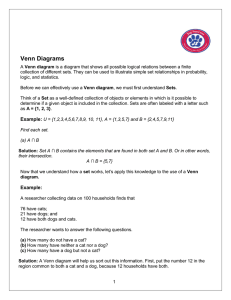Sets - MathXTC
advertisement

SETS
Sets are denoted by
Capital letters
Sets use “curly” brackets
A = {1, 3, 2, 5}
n(A) = | A | = 4
The number of elements
in Set A is 4
3 A
7 A
3 is an element of A
7 is not an element of A
A set is a distinct collection of objects. The objects are
called elements.
Order does not matter. If a set
{1, 2, 3, 4} = {2, 3, 1, 4} contains the same elements as
another set, the sets are equal.
{1,2,3,2,3,2,3,5,5}
5}
{1, {1,
3,
2}
In ascending
order
We
never repeat
elements in a set.
This symbol means "is a subset of"
AB
This is read "A is a subset of B".
A = {1, 2, 3}
B = {1, 2, 3, 4, 5}
If a set doesn't contain any elements it is called the
empty set or the null set. It is denoted by or { }.
NOT {}
It is agreed that the empty set is a subset of all other sets
so:
A
A where A is any set.
List all of the subsets of {1, 2, 3}.
{1}
{2}
{3}
{1, 2}
Notice the empty
set is NOT in set
brackets.
{1, 3}
{2, 3}
{1, 2, 3}
Number of
Elements in Set
Possible Subsets
Total Number of
Possible Subsets
1. {A}
{A}
2
2. {A , B}
{A , B} {A} {B}
4
3. {A , B , C}
{A , B , C} {A , B} {A , C}
{B , C} {A} {B} {C}
8
4. {A , B , C, D}
{A , B , C , D} {A , B , C} {A
, B , D} {A , C , D}
{B , C , D} {A , B} {A , C}
{A , D} {A , B} …… {D}
?
16
The number of possible subsets of a set of size n is ? n
2
A = {1, 2, 3, 4, 5} B = {1, 3, 5, 7, 9}
AB
= {1, 2, 3, 4, 5, 7, 9}
Remember we do
not list elements
more than once.
This is the union symbol. It means the set that consists of all
elements of set A and all elements of set B.
AB
= {1, 3, 5}
This is the intersect symbol. It means the set
containing all elements that are in both A and B.
These sets can be visualized with circles in what is called a
Venn Diagram.
A
A
B
B
A
B
AB
AB
Everything that is in
A or B.
Everything that is in
A AND B.
Often will have a set that contains all elements that we
wish to consider. This is called the universal set. All other
sets are subsets of this set.
AB=
Universal Set
AA
A
BA
There are no
elements in
both A and B.
When this is
the case they
are called
disjoint sets.
This means the complement of A, and
means the set of all elements in the
universal set that are not in A.
100 people were surveyed. 52 people in a survey owned a
cat. 36 people owned a dog. 24 did not own a dog or cat.
Draw a Venn diagram.
52 + 36 = 88 so
there must be
88 - 76 = 12
people that own
both a dog and
a cat.
universal set is 100 people surveyed
C
40
12
D
24
24
Set C is the cat owners and Set D is the dog
owners. The sets are NOT disjoint. Some
people could own both a dog and a cat.
Counting Formula:
n(A B) = n(A) + n(B) - n(A B)
Since 24
did not own
a dog or
cat, there
must be 76
that do.
n(C D) = 76
This n means the
number of elements
in the set
Acknowledgement
I wish to thank Shawna Haider from Salt Lake Community College, Utah
USA for her hard work in creating this PowerPoint.
www.slcc.edu
Shawna has kindly given permission for this resource to be downloaded
from www.mathxtc.com and for it to be modified to suit the Western
Australian Mathematics Curriculum.
Stephen Corcoran
Head of Mathematics
St Stephen’s School – Carramar
www.ststephens.wa.edu.au









